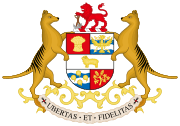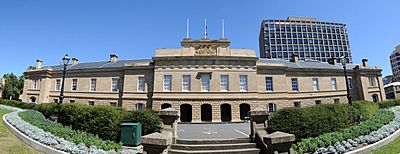Government of Tasmania facts for kids

Tasmanian coat of arms featuring two thylacines
|
|
| Formation |
|
|---|---|
| Australian state | Tasmania |
| Website | http://www.tas.gov.au/ |
| Legislative branch | |
| Legislature | Parliament of Tasmania;
|
| Meeting place | Parliament House |
| Executive branch | |
| Leader | Premier |
| Appointer | Governor |
| Meeting place | Parliament House |
| Judicial branch | |
| Court | Supreme Court |
| Seat | Hobart |
The Government of Tasmania is the group of people and rules that manage the state of Tasmania. It is also called the Tasmanian Government. It works like a parliamentary constitutional monarchy. This means it has a parliament and a King or Queen (represented by the Governor).
The Tasmanian Government was set up in 1856. In 1901, Tasmania became a state of the Commonwealth of Australia. The Constitution of Australia explains how Tasmania works with the Australian Government. Tasmania gave some of its law-making and court powers to the Commonwealth. But it kept its independence in most other areas.
Contents
How Tasmania's Government Works
Tasmania's government follows the Westminster System. This is a type of government based on the system used in the United Kingdom. It has three main parts:
- Legislative Power: This is about making laws. It belongs to the Parliament of Tasmania. The Parliament includes the Crown (represented by the Governor of Tasmania) and two houses: the Tasmanian Legislative Council and the Tasmanian House of Assembly.
- Executive Power: This is about carrying out the laws. It is officially held by the Executive Council. This council includes the Governor and important ministers. In practice, the Premier of Tasmania and the Cabinet use this power. They are chosen by the Governor. They stay in power as long as they have the support of most members in the House of Assembly.
- Judicial Power: This is about interpreting laws and making sure they are followed. It is handled by the Supreme Court of Tasmania and other local courts. However, the High Court of Australia and other federal courts can overrule them on matters covered by the Australian Constitution.
Who is in Charge Now?
The group of ministers currently leading Tasmania is called the Hodgman Ministry. It includes nine members from the Liberal Party. Each minister is in charge of different areas.
| Role | Minister |
|---|---|
|
Premier |
Will Hodgman, MP |
|
Deputy Premier |
Jeremy Rockliff, MP |
|
Minister for Health |
Michael Ferguson, MP |
|
Attorney-General |
Vanessa Goodwin, MLC |
|
Minister for State Growth |
Matthew Groom, MP |
|
Treasurer |
Peter Gutwein, MP |
|
Minister for Police, Fire and Emergency Management |
Rene Hidding, MP |
|
Minister for Human Services |
Jacquie Petrusma, MP |
|
Minister for Resources |
Guy Barnett, MP |
Tasmania's Parliament Houses
Tasmania's Parliament has two parts, or "houses," that work together to make laws. Both houses have met in Parliament House in Hobart since 1841. This building was first meant to be a customs house. But it became the home of the parliament when Tasmania gained self-government.
House of Assembly: The Lower House
The House of Assembly is the "lower house" of Tasmania's parliament. It has 25 members. These members are elected from five areas called divisions: Bass, Braddon, Denison, Franklin, and Lyons. Each division elects five members.
People vote using a system called Hare-Clark. This system helps make sure that different groups are fairly represented. Members are elected for up to four years.
| Party | Seats held | Percentage of Assembly | Current House of Assembly | ||||||||||||||
|---|---|---|---|---|---|---|---|---|---|---|---|---|---|---|---|---|---|
| Liberal Party of Australia | 15 | 60% | |||||||||||||||
| Australian Labor Party | 7 | 28% | |||||||||||||||
| Tasmanian Greens | 3 | 12% | |||||||||||||||
Legislative Council: The Upper House
The Legislative Council is the "upper house" of Tasmania's parliament. It has 15 members. Each member represents one of 15 different areas. These areas include Apsley, Montgomery, and Huon.
Elections for the Legislative Council happen every year in May. Members serve for six years. This means that only some members are elected each year, not all at once.
| Party | Seats held | Current Legislative Council | ||||||||||||
|---|---|---|---|---|---|---|---|---|---|---|---|---|---|---|
| Australian Labor Party | 1 | |||||||||||||
| Liberal Party of Australia | 2 | |||||||||||||
| Independents | 12 | |||||||||||||
Tasmanian Government Agencies and Businesses
The Tasmanian Government provides many services to people. It also sets rules and policies. It does this through different agencies and departments. Each area is led by a government minister. These ministers are members of the Parliament.
As of April 2016, there were eight main government departments:
- Department of Education (DoE)
- Department of Health and Human Services (DHHS)
- Department of Justice (DoJ)
- Department of Police and Emergency Management (DPEM)
- Department of Premier and Cabinet (DPAC)
- Department of Primary Industries, Parks, Water and the Environment (DPIPWE)
- Department of State Growth
- Department of Treasury and Finance
Many other agencies help these departments do their work.
Businesses Owned by the State
The Tasmanian Government also owns and runs several companies. These are called state-owned businesses. They provide important services to the public.
- Aurora Energy: Sells electricity and gas.
- Forestry Tasmania: Manages public forests for wood.
- Hydro Tasmania: Generates electricity, mostly from water power.
- Irrigation Tasmania: Plans and builds systems to bring water to farms.
- Metro Tasmania: Runs public buses in cities.
- Motor Accidents Insurance Board (MAIB): Provides public insurance for car accidents.
- Port Arthur Historic Site Management Authority: Manages the historic Port Arthur site for tourism.
- Public Trustee: An independent group that helps manage money and property for people.
- Tascorp: Manages the money of other public companies and government investments.
- Tasmanian Rail: Transports goods by train and manages railway lines.
- TasNetworks: Manages the power lines that deliver electricity.
- TasPorts: Manages ports and shipping.
- Tasracing: Manages horse and dog racing venues and betting.
- TasWater: Manages water and sewerage systems and sells water.
- TT-Line Company: Operates the ferries that travel across Bass Strait.
Other Levels of Government in Tasmania
Tasmania is part of Australia, so it also works with the national government and local councils.
Tasmania's Role in the Federal Government
As an Australian state, Tasmania has representatives in the national parliament. It has five members in the Australian House of Representatives. These members come from the same five areas as the state's House of Assembly. Tasmania also has twelve Senators in the Australian Senate, just like other states.
Local Government in Tasmania
Tasmania has 29 local government areas. These are like local councils. They include six cities, such as Hobart and Launceston. There are also 23 smaller areas called municipalities.
Local elections happen every two years in September and October. People vote for a Mayor, Deputy Mayor, and half of the councillors. They also use the Hare-Clark voting system for these elections.


